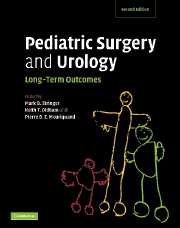Book contents
- Frontmatter
- Contents
- List of contributors
- Acknowledgments
- Preface
- Part I General issues
- Part II Head and neck
- Part III Thorax
- Part IV Abdomen
- 20 Abdominal surgery: general aspects
- 21 Abdominal wall defects
- 22 Inguinal and umbilical hernias
- 23 Infantile hypertrophic pyloric stenosis
- 24 Small bowel disorders
- 25 Cystic fibrosis
- 26 Necrotizing enterocolitis
- 27 Inflammatory bowel disease in children
- 28 Intestinal failure
- 29 Appendicitis
- 30 Hirschsprung's disease
- 31 Anorectal malformations: experience with the posterior sagittal approach
- 32 Gastrointestinal motility disorders
- 33 The Malone antegrade continence enema (MACE) procedure
- 34 Splenectomy
- 35 Biliary atresia
- 36 Choledochal cyst
- 37 Biliary stone disease
- 38 Portal hypertension
- 39 Persistent hyperinsulinemic hypoglycemia in infancy
- 40 Acute and chronic pancreatitis in children
- Part V Urology
- Part VI Oncology
- Part VII Transplantation
- Part VIII Trauma
- Part IX Miscellaneous
- Index
- Plate section
- References
22 - Inguinal and umbilical hernias
from Part IV - Abdomen
Published online by Cambridge University Press: 08 January 2010
- Frontmatter
- Contents
- List of contributors
- Acknowledgments
- Preface
- Part I General issues
- Part II Head and neck
- Part III Thorax
- Part IV Abdomen
- 20 Abdominal surgery: general aspects
- 21 Abdominal wall defects
- 22 Inguinal and umbilical hernias
- 23 Infantile hypertrophic pyloric stenosis
- 24 Small bowel disorders
- 25 Cystic fibrosis
- 26 Necrotizing enterocolitis
- 27 Inflammatory bowel disease in children
- 28 Intestinal failure
- 29 Appendicitis
- 30 Hirschsprung's disease
- 31 Anorectal malformations: experience with the posterior sagittal approach
- 32 Gastrointestinal motility disorders
- 33 The Malone antegrade continence enema (MACE) procedure
- 34 Splenectomy
- 35 Biliary atresia
- 36 Choledochal cyst
- 37 Biliary stone disease
- 38 Portal hypertension
- 39 Persistent hyperinsulinemic hypoglycemia in infancy
- 40 Acute and chronic pancreatitis in children
- Part V Urology
- Part VI Oncology
- Part VII Transplantation
- Part VIII Trauma
- Part IX Miscellaneous
- Index
- Plate section
- References
Summary
Inguinal hernia
The patent processus vaginalis is the common element in the pathogenesis of both congenital indirect inguinal hernia and congenital hydrocele. A wide patent processus creates a hernia by permitting the passage of intra-abdominal organs into the hernia sac, a hydrocele has a narrower processus permitting the passage of intraperitoneal fluid only. An inguinal hernia commonly presents as a reducible groin mass emerging from the external inguinal ring, lateral to the pubic tubercle, and may extend into the scrotum.
Congenital indirect inguinal hernias are one of the most common surgical conditions in infancy with a peak incidence in the first three months of life, occurring in approximately 3.5 to 5% of full-term neonates. In premature infants the incidence increases further, up to approximately 30%.
Boys have an increased incidence (male to female ratio between 8:1 and 12:1). In both sexes the incidence of right-sided inguinal hernia is higher than left (right 64%, left 29%, bilateral 7%). Consequently, patients presenting initially with a left-sided hernia have a higher probability of developing a metachronous hernia.
Specific abnormalities predispose to the development of inguinal hernia early in life. Prematurity is the most important risk factor (Table 22.1). These conditions represent part of a whole spectrum of incomplete obliteration of the processus vaginalis which leads to the potential development of both hydroceles and inguinal hernias.
Historical aspects
There is evidence from 1552 BC that the Egyptians described inguinal hernias controlled by external pressure.
- Type
- Chapter
- Information
- Pediatric Surgery and UrologyLong-Term Outcomes, pp. 286 - 295Publisher: Cambridge University PressPrint publication year: 2006
References
- 1
- Cited by

